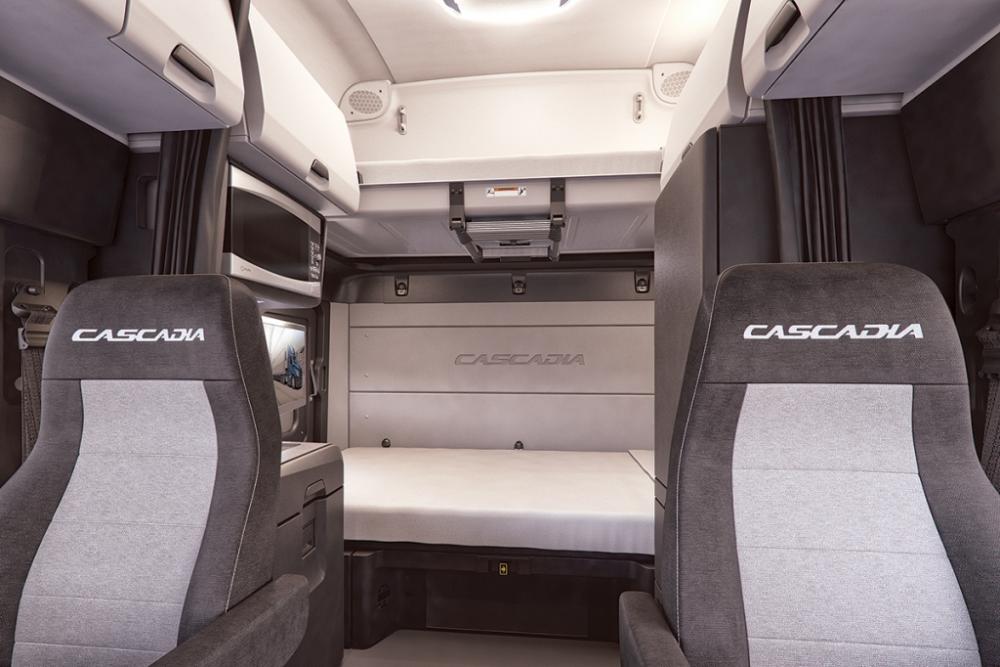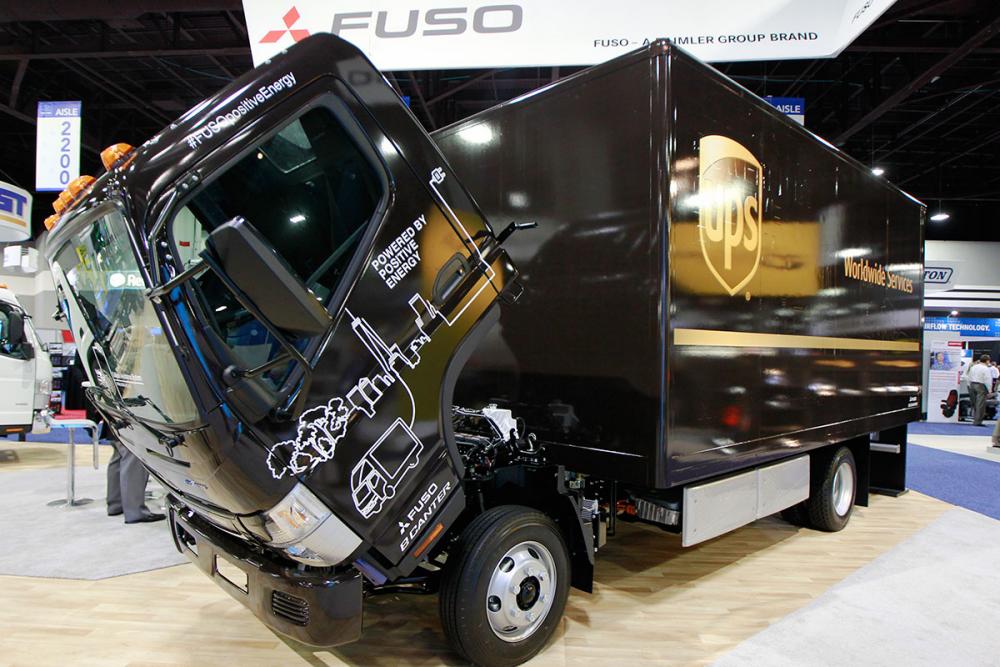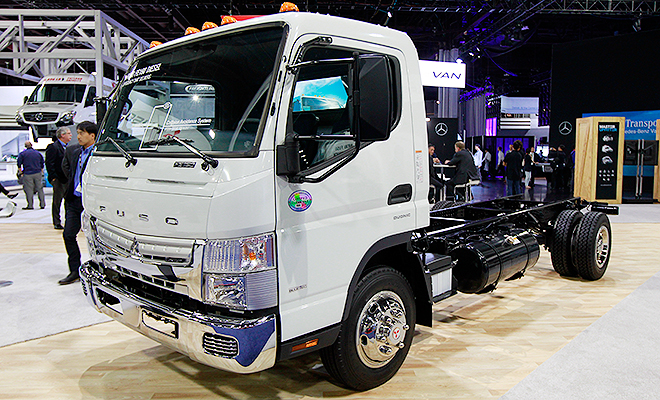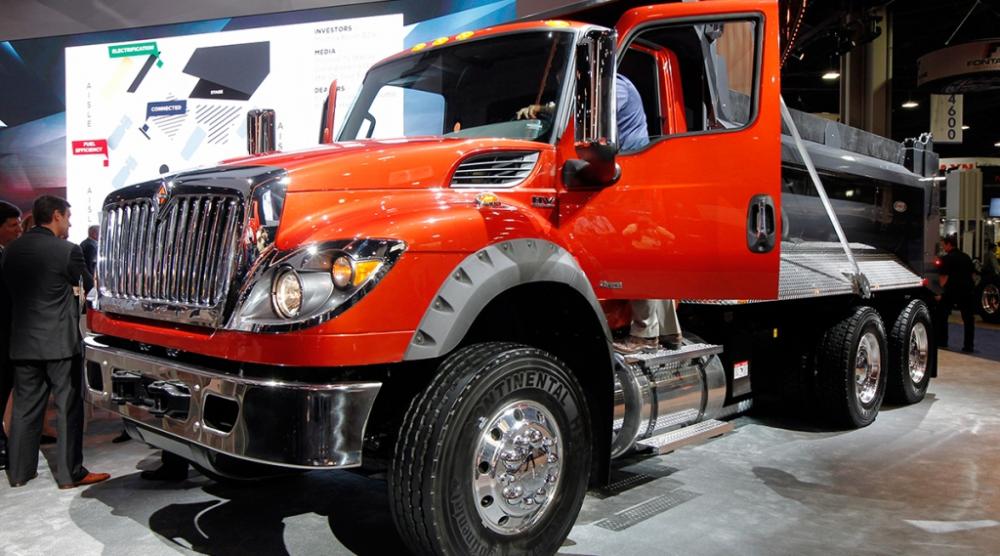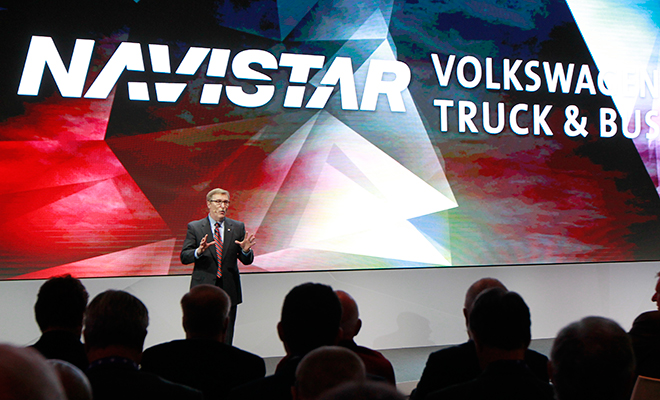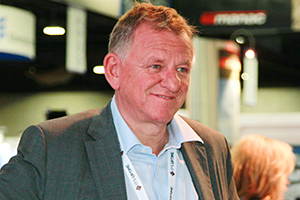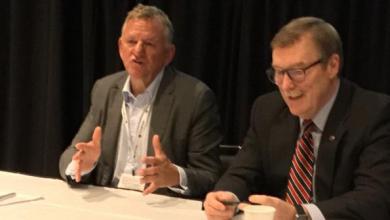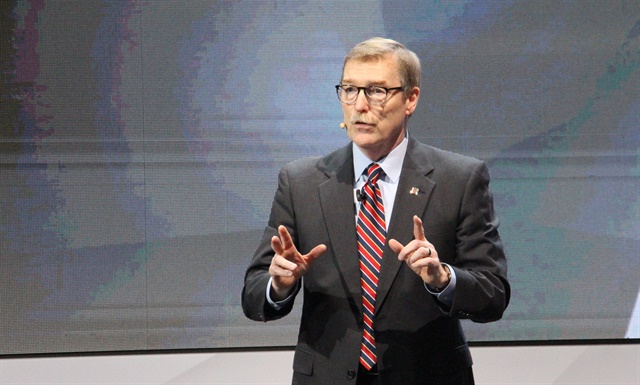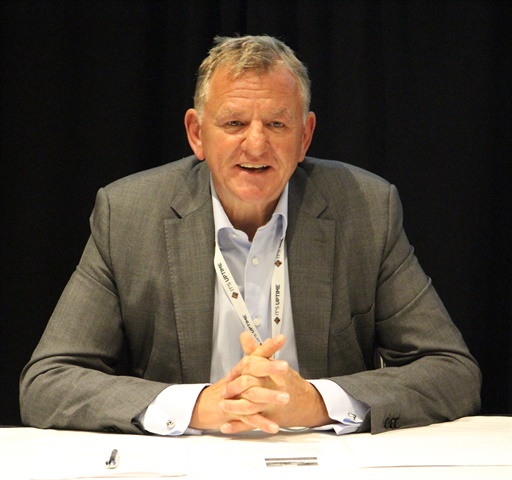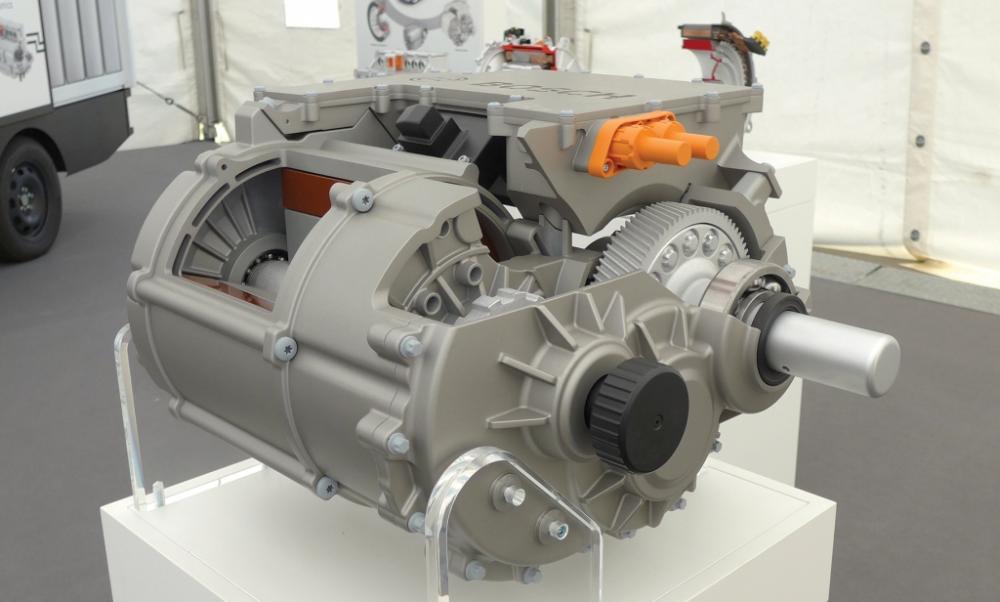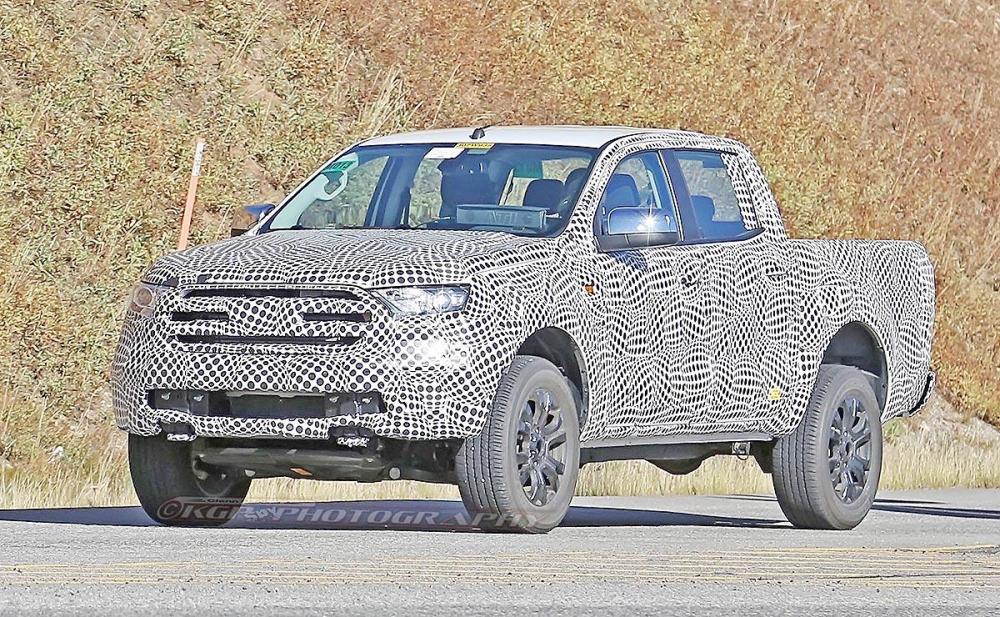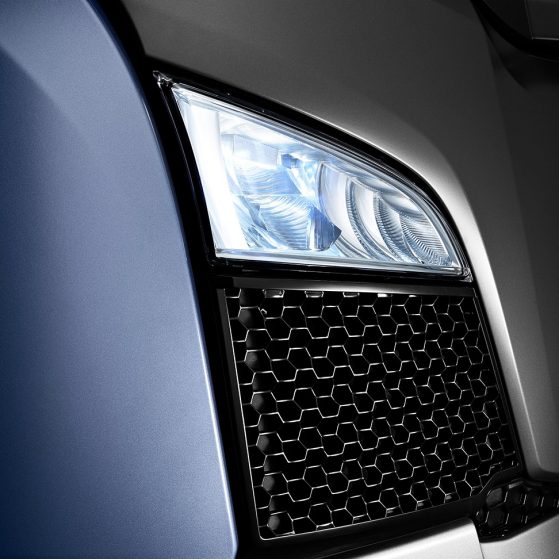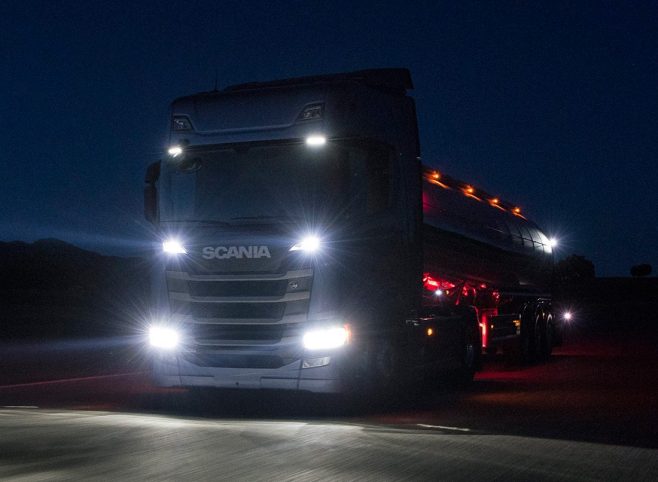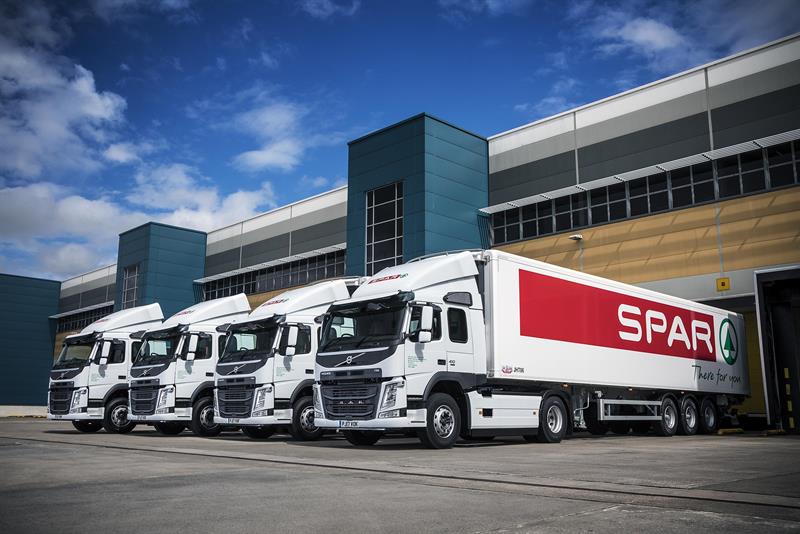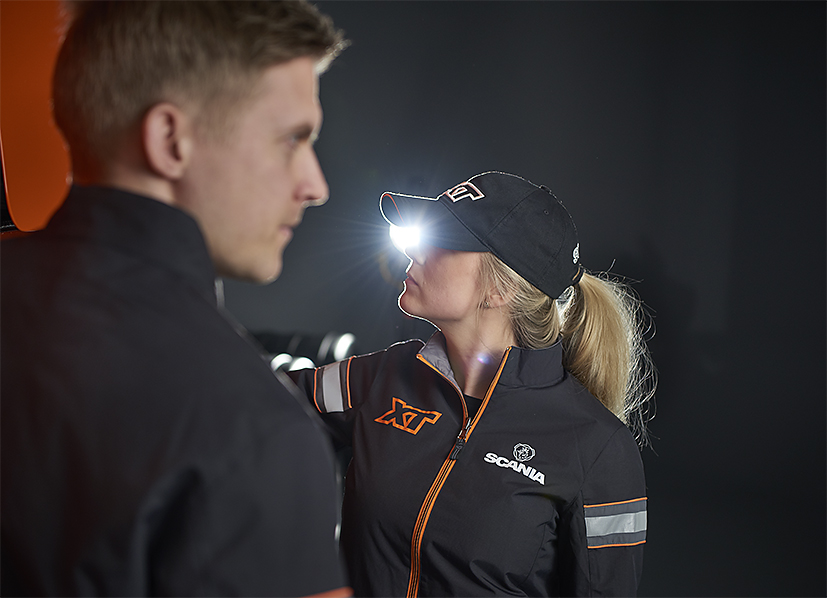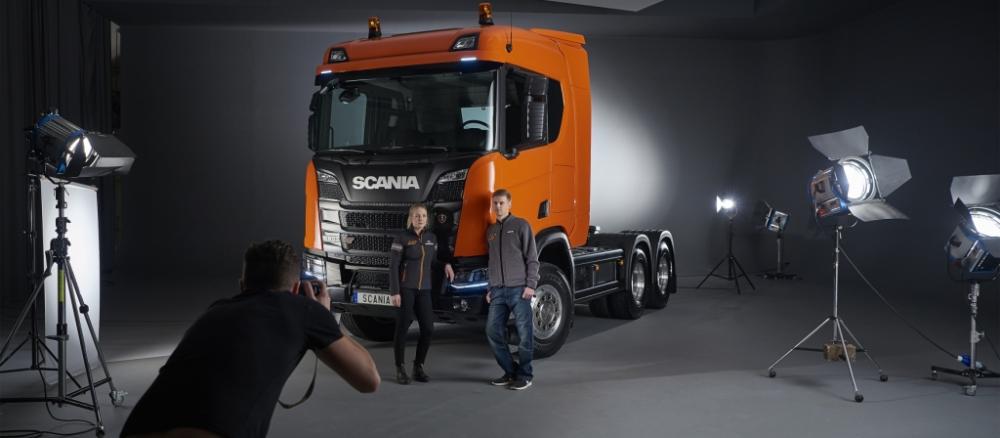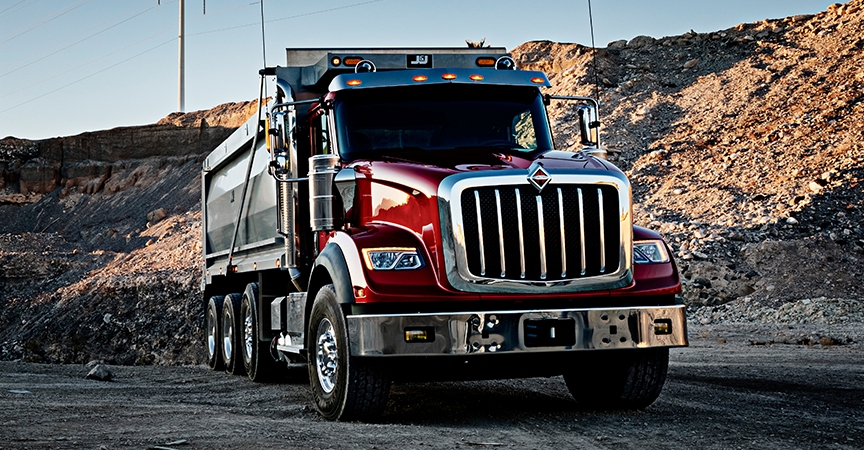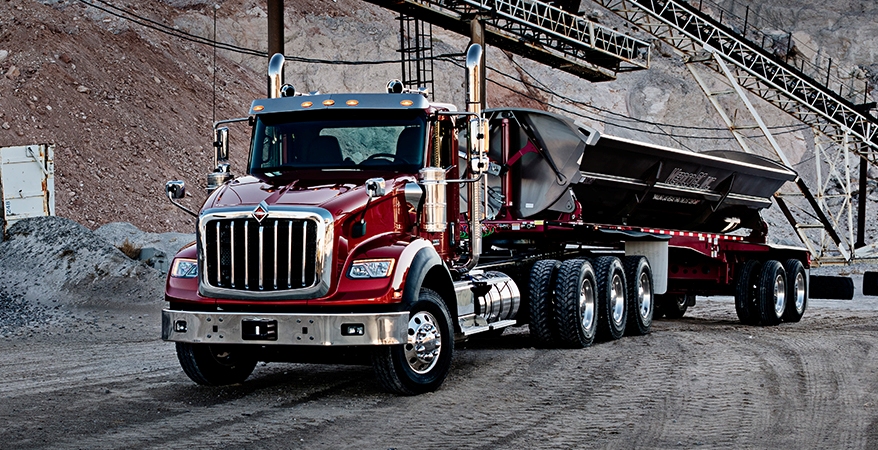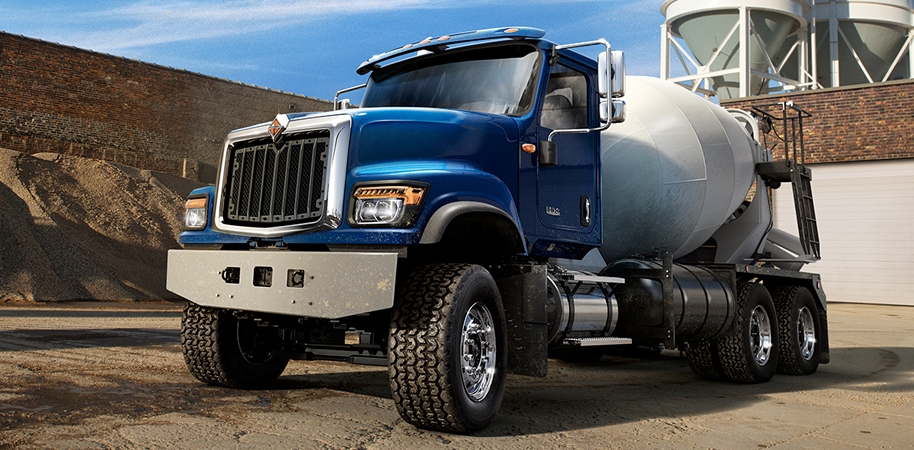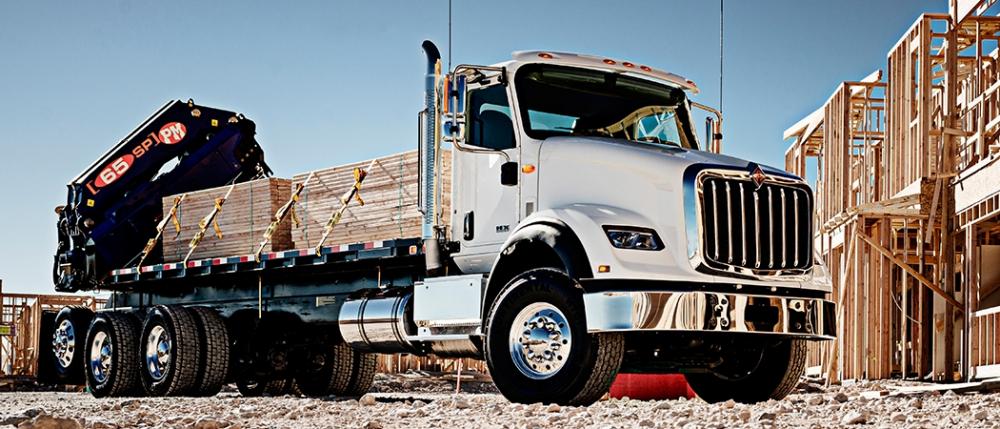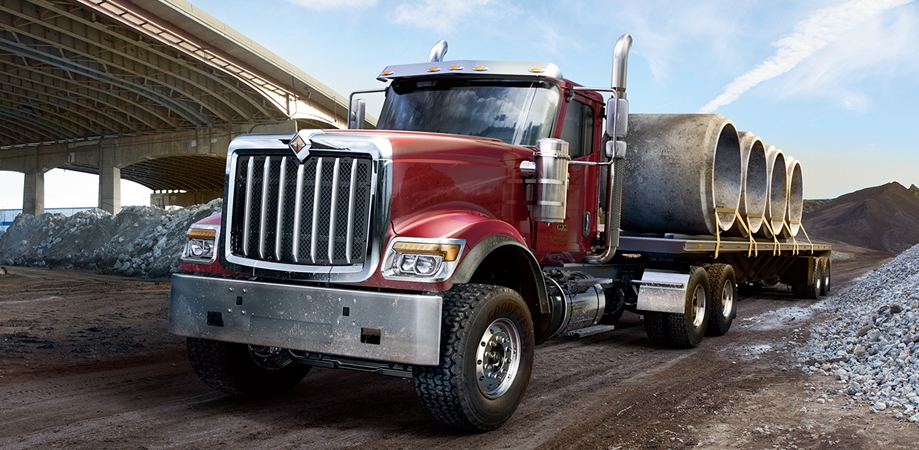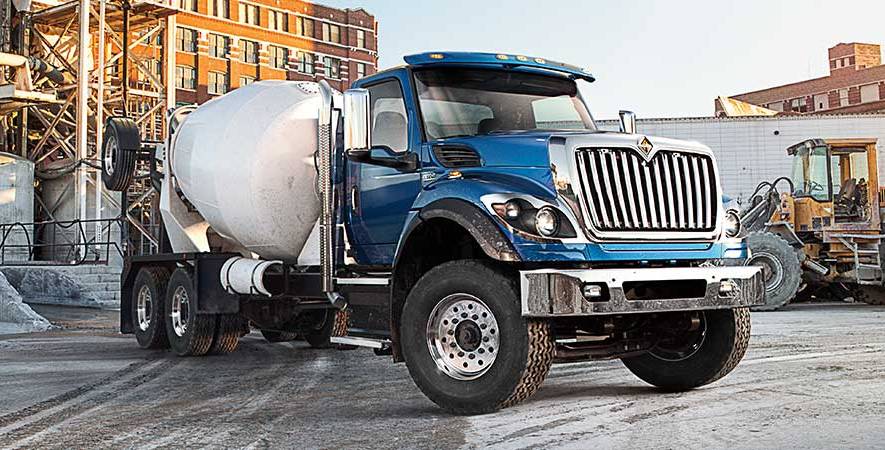
kscarbel2
Moderator-
Posts
18,895 -
Joined
-
Days Won
114
Content Type
Profiles
Forums
Gallery
Events
Blogs
BMT Wiki
Collections
Store
Everything posted by kscarbel2
-
Freightliner Offers New Cab Configurations for Cascadia
kscarbel2 replied to kscarbel2's topic in Trucking News
Freightliner Cascadia Adds Midroof Sleepers Transport Topics / September 25, 2017 ATLANTA — Daimler Trucks North America announced that its refreshed Freightliner Cascadia model will add midroof sleeper berths for regional overnight haul applications and segments such as bulk haul and flatbeds. The configurations include 48-, 60- and 72-inch midroof XT sleeper cabs in both 116- and 126-inch bumper to back of cab lengths. All three configurations offer two levels of aerodynamic packages, the Aero or AeroX, the company’s most fuel-efficient specification, according to DTNA. The truck gets LED-lit interior and exterior lights and an ergonomic dashboard and display screen designed to help drivers access gauges and switches without reaching. A loft option is available in the 72-inch midroof XT configuration features a two-seat dinette-work table and opposing seating. These seats can be folded flat to allow a full Murphy-style bed to swing down in less than 15 seconds, according to DTNA. “The addition of the midroof configuration allows more customers in different applications to experience the benefits of the new Cascadia,” said Mike McHorse, DTNA’s manager for on-highway product marketing. . -
Transport Topics / September 25, 2017 ATLANTA — Daimler Trucks North America expanded the powertrain offerings of its medium-duty Fuso cabovers with the introduction of an electric-powered version of its Fuso Canter truck, and a gasoline option for its FE-Series model. The powertrain of the Class 4 all-electric Fuso eCanter contains six 420-volt Mercedes-Benz lithium-ion battery packs with a total capacity of 82.8 kWh. The truck has a gross vehicle weight rating of 15,995 pounds, a range of more than 60 miles and a body/payload capacity of approximately 9,380 pounds, depending on body and usage, DTNA said in a release issued here at the inaugural North American Commercial Vehicle show. The company said that the eCanter offers operating cost savings up to $2,000 per 10,000 miles of operation when compared to an equivalent diesel truck. “This is really more than a product launch for us; it is a game changer, a revolution in the making,” Fuso CEO Jecka Glasman said. The first production models will reach customers this year in the United States, Europe and Japan, and Fuso plans to deliver 500 units of this generation to customers within the next two years. Larger scale production is intended to start in 2019. Plus, Fuso Vice President for Sales Operations Bill Lyons noted during the presentation that the next generation eCanter is already under development. Near-term, the first U.S. commercial partner for the eCanter will be UPS. “At UPS, we constantly evaluate and deploy advanced technologies that enable sustainable, innovative solutions for our fleet,” said Carlton Rose, UPS president for global fleet maintenance and engineering. “Electric trucks make our fleet both cleaner and quieter, adding to our already more than 8,500 alternative drivetrain vehicles in service today.” Other initial customers for the truck are coming through the office of New York Attorney General Eric Schneiderman, who is working with Fuso to supply a fleet of eCanters to New York-based not-for-profits, including the Wildlife Conservation Society, New York Botanical Garden, Habitat for Humanity New York City and Big Reuse Brooklyn. Operations looking for a gasoline-powered option will soon have it when Fuso adds a General Motors 6.0 engine to its FE-series lineup. The FE140 and FE160 will get the engine first; the gas-powered FE180 is still under development, Glasman said. All three trucks will also get an Allison 1000 six-speed automatic transmission, and will also offer power takeoff capability. The gas-powered FE-series trucks will be the first Fuso vehicles assembled in the United States, at Daimler’s Freightliner Custom Chassis Corporation factory in Gaffney, S.C., using engines and transmissions built in the U.S., and chassis, cabs and axles sourced from Fuso in Europe and Japan. Customer trials for a limited number of the gas trucks are scheduled to start in the fourth quarter, with full market launch to follow in the first quarter of 2018, as a 2019 model, Fuso said. . .
-
Navistar Announces New HV Severe Service Model Transport Topics / September 25, 2017 Further Integration With VW Moves Quickly ATLANTA — Navistar International Corp., the parent company of International Truck, announced its new HV model intended for severe service applications in North America. At the same, Navistar’s collaboration is accelerating with Volkswagen Bus & Truck, a unit of Volkswagen AG, with whom it forged an alliance in 2016, it said. The HV will be available with Navistar’s new 12.4 liter engine, the A26, which uses the MAN D26 crankcase, according to Navistar. MAN is a unit of Volkswagen Bus & Truck. “It’s all about [putting the] driver first. We designed this truck from the inside out imagining a space for drivers who operate these kinds of trucks,” said Denny Mooney, senior vice president of global product development. “Also, it is designed for easy body mounting [to accommodate various applications].” The company made its announcements at the inaugural North American Commercial Vehicle Show here Sept. 25. Meanwhile, the two truck makers agreed to collaborate on a fully integrated next generation “big bore” powertrain for Navistar, Navistar Chairman and CEO Troy Clarke said. “We believe a proprietary powertrain is important for Navistar, for dealers and, most importantly, for our customers.” Clarke declined to reveal details of the powertrain intended for North American customers at this time, citing competitive reasons. “It is set to launch as early as 2021,” he said, which is also when the first of three planned increases in greenhouse gas Phase 2 emissions requirements kicks in for medium- and heavy-duty trucks. The other two timetables are 2024 and 2027. Also, Navistar and Volkswagen Truck & Bus intend to converge their separate connectivity activities — Navistar’s OnCommand Connection and Volkswagen’s RIO — to a Volkswagen Truck & Bus “global connected vehicle platform,” according to Navistar. The initial step will be the adoption of common, in-cab connecting device hardware for a network with roughly 650,000 vehicles worldwide — of which, 350,000 are in the U.S. — thereby “making it the world’s largest global ecosystem for commercial vehicles, once the migration is completed,” Clarke said. Volkswagen Truck & Bus expects to launch the cloud-based, brand-independent platform by the end of the year, according to Navistar. “We don’t view it as there is a European cloud and a North American cloud. There is just a cloud and it is around the world,” Clarke said. “No matter where trucks are being run, there is a protocol so they can reach up and pull that data to drive their business systems.” Asked if the alliance was unfolding at the pace he expected, Andreas Renschler, head of VW’s global Truck & Bus division, said, “From my experience, it is much faster than I thought.” Clarke added: “I would have thought that we would still be grappling with a handful of issues around technical specs and stuff related to engines. I’m telling you, we got through that kind of stuff really quick. Or can we put together these two purchasing processes? That stuff was through in weeks. I didn’t think we’d be talking about electric trucks or merging our digitalization strategies, but it makes a lot of sense.” The alliance was completed in March. In the meantime, Navistar’s existing OnCommand Connection telematics product will be updated to include live action plans that predict when a part is going to fail before it actually does. The telematics system will then alert customers about the potential repair, the parts needed for the repair and the training needed for the repair, according to the company. The feature will be available in 2018. Also, the companies’ procurement joint venture based in Lisle, Ill., — Global Truck & Bus Procurement — has met with more than 250 new and existing suppliers, and completed 40 joint bidding contracts, according to Navistar. Navistar also said two-truck platooning using its vehicles, in cooperation with applications developer Peloton Technology, will be available in 2018, too. Plus, Navistar announced it will launch Classes 6-7 trucks with an electric powertrain in late 2019 or early 2020, given the trucks’ abundance of packaging space, and that they typically run short distances and can recharge at the end of the day. “Currently, the Cummins ISB engine is the mainstay of our medium-duty product. We don’t offer a different engine. It performs great. It has a great product following,” Clarke said. Also, Navistar has added updates to its HX series vocational trucks, including offering 51-inch sleepers in the 550 and 650 models, beginning in October. These two HX models also will be available with the A26 engine, starting in May 2018, according to the company. . .
-
Navistar, VW will collaborate on electric truck, connectivity
kscarbel2 replied to kscarbel2's topic in Trucking News
Navistar, VW to develop new diesel engines, medium-duty electric truck Neil Abt, Fleet Owner / September 25, 2017 ATLANTA - Navistar International Corp. said it plans to develop fully integrated diesel big bore powertrains in conjunction with Volkswagen Truck & Bus for the North American market in 2021. The announcement was part of a joint media event on Sept. 25 at the North American Commercial Vehicle show. VW last year agreed to purchase a 16.94% stake in Navistar – a deal that formally closed in March. At NACV, the companies also said they will develop an electric-powered, medium-duty vehicle for the United States and Canada in late 2019 or early 2020. “Our alliance with Volkswagen Truck & Bus is allowing us to move much more quickly into electric propulsion thanks to our ability to leverage their technology investments and components in segments of the market where we’re already a leader,” said Troy A. Clarke, Navistar’s chairman, president, and CEO. “We believe the Class 6/7 vehicle is ideal for electric powertrain solutions in the near term, given its abundance of packaging space, and that these vehicles typically run short distances and can depot to recharge at the end of the day.” During the press event, Clarke and Andreas Renschler, CEO of Volkswagen Truck & Bus, unveiled the companies will converge their connectivity platform – Navistar’s OnCommand Connection and VWs RIO – creating a single global connected platform that would cover about 650,000 vehicles worldwide. That will begin with the adoption of common, in-cab connecting device hardware. Apart from the news related to the joint venture, Navistar shared a series of other developments, including the launch of the HV truck available with the International A26 12.4 liter engine. Additionally, it said a 51-inch sleeper cab is now an available for both its HX520 and HX620 vocational models. The A26 engine is also now an option for the full HX series, Navistar said. Several upcoming enhancements to OnCommand Connection were also shown, including a “live action” feature that can better predict problems with parts before there is a failure. . -
Navistar, VW will collaborate on electric truck, connectivity
kscarbel2 replied to kscarbel2's topic in Trucking News
Navistar-VW Alliance to Bring Electric Truck, Integrated Powertrain to Market Heavy Duty Trucking (HDT) / September 25, 2017 ATLANTA – The Navistar-Volkswagen Truck & Bus Alliance has borne fruit faster than either company expected, and officials announced Monday at the inaugural North American Commercial Vehicle Show. they will develop a proprietary, integrated powertrain; a common connected vehicle and cloud platform; and an electric-powered Class 6/7 truck. Navistar expects to be in a position to launch its first medium-duty electric powered vehicle for the U.S. and Canadian markets in late 2019 or early 2020. "We believe the Class 6/7 vehicle is ideal for electric powertrain solutions in the near term, given its abundance of packaging space, and that these vehicles typically run short distances and can depot to recharge at the end of the day,” said Troy A. Clarke, chairman, president and CEO, Navistar. Clarke pointed out that Navistar was “probably ahead of its time” when it launched the eStar electric vehicle back in 2010, “but we never gave up believing there is an application for electric commercial vehicles in the North American commercial vehicle market,” he said. Clarke also noted that electric power for commercial vehicles is particularly growing in urban areas, “where congestion often leads to air quality issues.” In fact, Volkswagen has already delivered the first 10 electric trucks to an Austrian customer for testing, said Andreas Renschler, CEO of Volkswagen Truck & Bus. “For us, the customer’s view is first and foremost in priority. If the customer tells us what he or she wants to do with electric trucks we can deliver.” Renschler said he couldn’t answer media questions about things like how many such vehicles they expect to sell, because “Of course it depends on customers. The question for us is not to tell them what to do; they tell us what we should do with such a solution, but we can offer the innovation. I think electrical buses for example are important, but also the medium truck, with so called last mile, we see a good chance for the customer to be able to use it.” Integrated Powertrain In preparation for the next greenhouse gas emission regulations globally, Navistar and VW also are collaborating on a fully integrated, next-generation diesel big bore powertrains for North America, launching in 2021. However, the two companies would offer no further details. “We'd love to say a lot more about that,” Clarke said, but didn’t want to divulge too much of the company’s future plans for fear of how the competition might use it against them. “I guarantee you this, the next one of these shows in 2019 it will all be very evident.” Asked if the powertrain would also include a proprietary transmission, Clarke and Renschler were noncommittal, saying such things were “possible.” Converging Connectivity Navistar and Volkswagen Truck & Bus also announced their intention to converge their connectivity activities – OnCommand Connection and RIO, Volkswagen Truck & Bus's digital brand – to a Volkswagen Truck & Bus global connected vehicle platform. The first step will be the adoption of common, in-cab connecting device hardware. This would serve as a major step toward creating a global connected platform, covering roughly 650,000 vehicles worldwide, "making it the world's largest global ecosystem for commercial vehicles, once the migration is completed," Clarke said. Volkswagen Truck & Bus expects to launch the cloud-based, brand-independent platform by the end of the year, which will be the basis for the cooperation. "Future transportation will massively be building on connectivity, as this will make our world much more efficient," said Renschler. "The ecosystem we are about to create with our common platform will drive our strategic alliance to the next level." Joint Venture Navistar also reported that the procurement joint venture – Global Truck & Bus Procurement LLC – it created with Volkswagen Truck & Bus is off to a strong start. The team has met with more than 250 new and existing suppliers, and to date, have completed 40 joint bidding contracts. "We're on track to achieve our expected cost savings thanks to our fast start with the procurement JV and the great progress on our technology collaboration," said Clarke. "As a result, we are in a much more competitive position today in the areas that are quickly revolutionizing our industry globally.” “Navistar is now writing the next chapter of our story,” Clarke said. “Unlike any time in our history, we are positioned to win, and we will. We have the products, we have the dealers, we have the partner, and most importantly we have the will to win. We have the resolve to fight the next battle and the one after that.” . -
Nikola Taps Bosch for eAxle, Other Key Components Transport Topics / September 25, 2017 Nikola Motor Co. announced Bosch Group will play a key role in supplying powertrain components for its over-the-road and day cab Class 8 hydrogen-electric trucks, which are scheduled to come to market in 2021. Stuttgart, Germany-based Bosch will supply Nikola with its eAxle, which has a motor, power electronics and transmission in one compact unit, according to Salt Lake City-based Nikola. The companies also announced they will jointly develop a custom-designed fuel cell system for the trucks. The overall vehicle controls will be jointly developed based upon Bosch’s vehicle control software and hardware. Referring to it as the “Nikola Bosch zero local emission powertrain,” the truck maker said in a statement that the system is designed to achieve “segment-leading performance” at a competitive total cost of ownership to traditional powertrains. “Bosch has empowered us to come to market quickly with automotive-grade hardware and software so our vision can become a reality,” Nikola founder and CEO Trevor Milton said in a statement. The trucks, first announced in December 2016, are intended to deliver more than 1,000 horsepower and 2,000 pound-feet of torque, according to Nikola. .
-
Ford Ranger interior spied during testing Automotive News / September 26, 2017 The interior of the 2019 Ford Ranger may look similar to that of the midsize pickup now sold in markets outside the U.S. Spy photos of a camouflaged Ranger testing in Colorado show a small infotainment screen flanked by a series of buttons. Underneath the screen are more buttons with two dials for volume and radio tuning. It's a design used on Rangers sold in Australia and other markets. The automaker also offers larger touch screens depending on the trim. The U.S. prototype's center console between the seats was not visible because of testing equipment. It's unclear how much of the prototype's interior design will carry over to production models. Ford traditionally does not comment on future products or camouflaged vehicles in spy photos. The photos also show more of the front grille than previous spy shots, with what appears to be Ford's standard tribar grille design. The spy photos also appear to show a more aggressive exterior design with a front skid plate and tow hooks mounted in the front bumper, suggesting Ford could offer an FX4 off-road package. Ford this year reintroduced an FX4 package for its redesigned 2018 Expedition SUV. Previous spy photos also suggest Ford will offer a Ranger Raptor variant. It's unclear what engine options the Ranger will have, but the engines are expected to be paired with Ford's new 10-speed transmission, which the automaker is rolling out across its lineup. Ford in January confirmed plans to revive the Ranger after years of rumors, with production of the 2019 model beginning late next year at the Michigan Assembly Plant in Wayne, Mich. It will compete in a segment that includes the Chevrolet Colorado, GMC Canyon and Toyota Tacoma. Ford last sold the Ranger in the U.S. in 2012, but it continues to build and sell it globally. Photo gallery - http://www.autonews.com/article/20170926/OEM04/170929846/2019-ranger-ford-spy-photo-interior .
-
Dressing for the job – Scania’s new construction clothes collection
kscarbel2 replied to kscarbel2's topic in Trucking News
-
You're welcome. I aim to please.
-
Iconic Australian Routes: Cannington Mine to Yurbi Rail
kscarbel2 replied to kscarbel2's topic in Trucking News
Related reading: https://www.bigmacktrucks.com/topic/47348-lindsay-fox-vows-to-never-retire/?tab=comments#comment-349310 -
Linfox Press Release / July 12, 2017 .
-
I happened upon a read on this subject. --------------------------------------------------------------------------------------------------- NFL should follow NCAA lead on national anthem at games Kerry Dougherty, News columnist / September 23, 2017 Can we all agree that college football is more fun to watch than the NFL? And not just because the pros are filled with grown men grinding for a paycheck, while most college players are barely out of their teens and prone to both crazy mistakes and brilliant plays. Sure, college teams in the Power Five are sprinkled with freaky athletes who have taken cash and swag under the table, but there are plenty of absolute amateurs: players who were overlooked in high school and guys simply playing a sport they love, knowing they’ll never go pro. Shoot, you didn’t have to be a Clemson fan to find yourself cheering for Cinderella wide receiver Hunter Renfrew in last January’s national championship win over Alabama. The Myrtle Beach native joined the Tigers as an undersized walk-on, only to become the star of the best team in college football. There’s another reason to prefer the NCAA over the NFL right now: The relative absence of politics and protests. At many college games, the national anthem is played while the players are still in the locker room. This has been the case for many years and apparently has to do with television schedules and the need to be ready to kick off at the precise moment the cameras blink on. I thought of that last Saturday night as I stood in the stands at Cal Berkeley. The players for both teams were off the field when the marching band began to play “The Star-Spangled Banner.” I saw thousands of football fans in this left-leaning oasis proudly wearing “Cal” jerseys, with their hands over their hearts, warbling the lyrics loudly and off-key just like fans everywhere. It was a beautiful moment. So why don’t NFL owners adopt the same schedule? Play the anthem while the players are in the tunnel. That way team members aren’t pressured to stand. And ticket holders are spared the spectacle of players kneeling. Problem solved. By now even those who don’t know a tailback from a touchback are aware that former San Francisco 49ers quarterback Colin Kaepernick started taking a knee during the anthem last season. That attention-grabbing act, by a player whose career was already in a slump, ignited other protests with players on various teams sitting or kneeling during the anthem as fans fumed in the stands. As I wrote last year, Kaepernick had a right to his nonviolent protest, just as some of us had a right to call his behavior rude. Look, politics are everywhere. And most of what passes for politics is ugly. Football is where some of us go to escape. We don’t want to be lectured or drawn into divisive debates while there, whether the instigators are players, owners, announcers, or quite frankly, the president of the United States. In a red meat speech at a political rally for Republican U.S. Senate candidate Luther Strange in Alabama on Friday night, President Donald Trump foolishly waded into the NFL controversy. He suggested that the protests would end if fans simply walked out every time players fell to their knees during the anthem. What, and miss the game, Mr. President? Those season tickets cost big bucks. Plus, people love football. The president urged owners to fire protesting players. “Wouldn’t you love to see one of these NFL owners, when somebody disrespects our flag, to say, ‘Get that son of a bitch off the field right now, out, ” Trump intoned, launching yet another controversy. he’s fired,’ Our bombastic president is partly right, owners can hire or fire players at will — depending on their clauses in their contracts, that is. But by popping off about the issue, Trump virtually guaranteed that the protests will continue. And spread. Look, standing for the national anthem is simply a sign of respect and affection for our imperfect nation. It doesn’t suggest agreement with everything going on in the country. If it did, no one would stand. Instead of kicking protesters off them team as Trump urged, owners should urge their players to follow their consciences. Tell them that they’re free to stand, sit or kneel. In the locker room.
-
-
Hyundai Commercial Vehicle Press Release / September 12, 2017 .
-
Daimler launches Mitsubishi Fuso eCanter in US market
kscarbel2 replied to kscarbel2's topic in Trucking News
-
Bharat Benz Press Release / September 22, 2017 Five years ago we introduced our first truck in India. To celebrate our anniversary we went on our biggest adventure yet. During our High Five Rally, we traveled 9000 kilometers in 35 days across the country to thank customers, fleet owners, dealers and truck drivers. Watch this video for impressions of our epic journey! Thank you for your trust! .
-
Transport Engineer / September 18, 2017 Spar wholesaler and distributor James Hall & Co has taken delivery of eight new Volvo trucks, six FM 4x2 tractors and two FE 6x2 rigids. Supplied by Thomas Hardie Commercials, the Lancashire-based operator’s new additions will serve 600 Spar stores in the north of England. The trucks all feature the Volvo 11-litre engine, rated at 410bhp in the tractors and 320bhp in the rigids, plus the I-Shift automated transmission. All are on seven-year Volvo Gold R&M contracts with the dealer. Ian Farnworth, fleet engineering manager, says the tractors are ideal for the delivery operation: “The FM has very good low entry which suits a multi-drop operation.” He adds: “Every vehicle we have is potentially operating in a multi-drop environment.” Farnworth says the decision was taken to specify the single-drive three-axle rigids, rather than two-axles, to meet the changing profile of the stores the company delivers to – making it possible for them to accommodate a larger delivery vehicle. The new vehicles join an 86-strong fleet, of which 52 are now Volvo trucks. There is an equal split between artics and rigids, with the artic fleet operating at a maximum gcw of 40 tonnes The operator runs some Gray & Adams 13.6 metre, dual-temperature, double-deck fridge trailers as well as a number of 11.2m dual-temperature spec tandems from the same manufacturer. .
-
Tenneco Supplying Diesel Aftertreatment for Daimler Trucks 2018 Medium-Duty Engine Platform Tenneco Press Release / September 25, 2017 ATLANTA—Tenneco announced today at the North American Commercial Vehicle (NACV) truck show in Atlanta that it will supply full aftertreatment systems for new Detroit DD5 and DD8 medium-duty engines. The four and six cylinder engines were developed to meet and exceed the rigorous demands of different global markets while complying with current and future emissions regulations. Tenneco will supply the full aftertreatment system, which includes the complete selective catalytic reduction system featuring the company’s proprietary mixing technology, as well as muffler and pipes. The system will be available in multiple understep, side-by-side and horizontal variations designed to accommodate the Daimler Trucks product portfolio, which includes Mercedes-Benz trucks and buses, Setra, Freightliner, Freightliner Custom Chassis, BharatBenz, FUSO, and Thomas Built Buses. “We are pleased to partner with Daimler Trucks to support the important launch of their global engine platform for medium-duty trucks,” said Brian Kesseler, chief executive officer, Tenneco. “This platform demonstrates Tenneco’s commitment to provide commercial truck customers with our most advanced aftertreatment solutions that meet the needs of the evolving global regulatory landscape, while enabling greater fuel economy and reduced CO2 emissions.” The aftertreatment system was designed and engineered at Tenneco’s technical center in Edenkoben, Germany, and will be manufactured and assembled at the company’s Clean Air facility in Seward, Nebraska. Tenneco is a global supplier to Daimler, providing both Ride Performance and Clean Air technologies on many light vehicle platforms globally in addition to commercial truck solutions.
-
Hendrickson 6x2 Liftable Forward Tandem Axle Available on Cascadia
kscarbel2 replied to kscarbel2's topic in Trucking News
Hendrickson Partners with Freightliner Trucks on 6x2 Liftable Forward Tandem Axle Hendrickson Press Release / September 25, 2017 ATLANTA, Georgia — Hendrickson Truck Commercial Vehicle Systems announced today at the North American Commercial Vehicle (NACV) Show they partnered with Freightliner Trucks to offer the OPTIMAAX 6x2 liftable forward tandem axle, exclusive to the new Cascadia. The new OPTIMAAX reduces weight, saves fuel and improves traction and maneuverability. The new OPTIMAAX axle will help fleet customers optimize the movement of variable loads, as well as assisting carriers with diminishing loads, such as bulk haulers and delivery vehicles that may have empty back hauls after carrying items such as groceries, livestock, beverages and fuel. It will also help fleets that focus on weight reduction and those who want to optimize fuel efficiency. Automated controls sense the load capacity and either lift or lower the axle without relying on the driver, maximizing time with a raised axle and enhancing traction. The benefits: · Boosting fuel efficiency · Reducing weight by 300 to 400 pounds over a comparable 6x4, allowing trucks to either carry additional weight or save fuel · Gaining traction when backing under trailers in soft soil or low traction conditions · Improving maneuverability when the lift axle is raised · Saving money on tolls where lift axles are not charged if lifted “This combines a leader in heavy trucks with a leader in suspension technology,” said Gerry Remus – General Manager Sales and Business Development for Hendrickson Truck Commercial Vehicle Systems. “It’s one more way we’re focused on engineering our product for efficiency, and are lowering the overall running costs for fleets,” added Remus. The OPTIMAAX 6x2 design is compatible with drum and air disc brakes, and it’s unique because the axle is fully welded, not bolted. That gives it additional strength and durability. -
Scania Press Release / September 25 2017 XT, Scania’s new range of trucks and solutions suited for the toughest operations, signals robustness. So does the clothes collection that’s coming with it. The new XT clothes collection celebrates the launch of Scania’s new range of trucks for the toughest challenges – and honours the construction drivers who will drive them. “These are the men and women who make the wheels spin when things get really rough,” says Sophie Haftor, Director Vehicle Accessories and Branding Products. Everything added to the new truck range has its function and is thought about from the user’s point of view. The same goes for the clothes. “It’s been fantastic to work with a completely new range within Scania,” says Susanna B Hansson, Product Manager for Scania Truck Gear. “It´s almost like a new V8 to us.” In the construction industry it’s all about heavy work. The XT clothes collection shows and supports the strength and power in the new Scania vehicles developed and designed for these tough operations. “Also, it has been great fun to work with new colours,” Hansson says. “In our standard Truck Gear collection, colours are more down to earth. Here, the XT Orange really stands out.” .
-
Daimler AG Press Release / September 25, 2017 Heroes don’t just exist on the silver screen. They live among us. Every day they get up before sunrise to keep our economy running. Every day they are willing to sacrifice time with their families to make our modern lives possible. And they do it with dedication, love and pride. Because they know that they are part of something bigger than themselves. We often don’t think about the work they do, but we can always rely on them to get the job done. These are the everyday heroes who keep the world moving. .
-
Navistar Press Release / September 25, 2017 - International® HX™ Series available with integrated 51" sleeper cab - Will be available with the International® A26 12.4L big bore engine ATLANTA -- International Truck today unveiled its most recent product expansion to its vocational truck portfolio at the inaugural North American Commercial Vehicle Show. Expanding the Class 8 premium vocational truck line-up, the International® HX™ Series is now available in a 51 inch sleeper cab on both the HX520 and HX620 models. The International® A26 engine, a powerful 12.4L engine designed to provide industry-leading uptime will be available in both the HX Series and the all new International® HV™ Series. "We're thrilled to bring even more options to the vocational truck market with products that are redefining the standard for uptime and productivity," said Michael Cancelliere, president, Truck and Parts. "With the introduction of the International A26 engine on our off-highway products, we continue to raise the bar for vocational and severe-service vehicles by including our big bore engine that will reliably provide our customers with the power and versatility to meet any application." Offering optimal maneuverability and excellent forward visibility designed with the industry's only dedicated vocational lightweight aluminum cab, available 3.5 million RBM 0.5" huck-bolted single rail frame, and set-forward front axle built to tackle stringent axle weight restrictions, the HX Series more than delivers. Plus, premium features such as an all-metal grille, available dual external chromed air cleaners and halogen headlamps with LED daytime running lights conveys strength and professionalism moving its driver to the head of the class. "In our pursuit to be the leader in putting the driver first in all of our truck design and product offerings, we listened to our customers and their desire to have a sleeper option in the HX Series, a premium Class 8 vocational truck," said Mark Stasell, vice president, Vocational Truck Group. "The HX520 and HX620 models will be available with an integrated 51" short sleeper cab for those drivers that need an incredibly rugged chassis designed to survive in punishing off-road applications and require a comfortable work space and roomy place to rest after a demanding day behind the wheel." The HX Series addresses a full range of applications for the severe service industry. The trucks were engineered to withstand the most punishing job sites and include prime features such as a 40 degree wheel cut with 425 series tires for improved maneuverability and an all-new standard cab air suspension for a supremely comfortable ride. The HX Series is purpose-built to deliver Uptime in every aspect of its productivity, efficiency, reliability and performance. "We're excited to offer our customers the International A26 engine, designed with uptime in its DNA, on the HX Series and across our vocational truck line-up," said Stasell. "Much like our Class 8 on-highway customers, they will experience a quieter ride, better fuel economy, and excellent corrosion prevention due to significant enhancements built into the engine. The A26 will include vocational ratings on the HX Series that will deliver application specific torque and power for any job site while giving drivers maximum comfort from a quieter ride." The HX515 and HX615 are powered by the International A26, a 12.4L engine, designed to provide industry-leading uptime, greater fuel efficiency, and quieter operation. Built from the proven MAN D26 engine crankcase, the A26 produces up to 475 horsepower and 1,700 lb.-ft. of torque from a design that is 600-700 lbs. lighter than a traditional 15L big bore engine. The A26 is also backed by the industry's best warranty and is the first engine to meet the B10 standard that requires 90% of delivered engines to travel 1,200,000 miles before a major repair. Four HX Series models are offered, with both set-forward and set-back front axle models in either short or long hood, depending on the application. The HX515 is a 114" BBC Set-forward Axle Straight Truck with primary vocations including concrete mixer, construction dump, refuse/roll-off and crane. The HX615 is a 115" BBC Set-back Axle Truck or Tractor with primary vocations including construction dump, concrete mixer, platform stake/crane and refuse/roll-off. The HX520, is a 120" BBC Set-forward Axle Truck or Tractor with primary vocations including heavy haul tractor, construction dump and platform stake/crane. The HX620 is a 119" BBC Set-back Axle Truck or Tractor with primary vocations including heavy haul tractor, construction dump and platform stake/crane. 51" Short Sleeper Cab will be available on the HX520 and HX620 models. The HX515 and the HX615 models are powered by International A26 engines, while the HX520 and HX620 models offer the Cummins® X15 engine. For more information on the HX Series or to locate a dealer, visit: InternationalTrucks.com/HXSeries. Visit International at Booth 4020 at the North American Commercial Vehicle Show 2017. .
-
International Truck Launches The New International HV Series At The North American Commercial Vehicle Show Navistar Press Release / September 25, 2017 - HV Series is a smart truck designed for serious work, brawn and brains - First severe service vehicle launched with the International® A26 big bore engine - Combines significant uptime enhancements with DriverFirst™ features and advanced integration options for body builders ATLANTA -- International Truck today launched the International® HV™ Series at the inaugural North American Commercial Vehicle Show. HV Series is the first severe service truck available with the International® A26 12.4L big bore engine and designed to deliver power, refined driver-features, and impressive reliability for a range of vocational applications. "The new International HV Series is just one more truck in our product lineup that puts drivers first and meets the grueling demands of vocational applications," said Michael Cancelliere, president, Truck and Parts. "The HV Series is a smart solution for our customers in the business of doing serious work and is a new breed of vocational truck that redefines the standard for uptime and productivity. It is the go-to truck for those who know that it's not just about getting the job done, it is about getting it done right." Redesigned from the inside out, the HV Series interior was crafted with driver and body company feedback to ensure the most comfortable and productive environment possible, while the exterior continues with powerful styling. The HV Series also features the intelligence of the industry-leading Diamond Logic® electrical system for the automation of tasks and interlocks to help protect both equipment and crew. The truck offers customers an incredibly versatile foundation for any configuration necessary to be productive at any job and includes power options like the International A26, an engine designed with uptime in its DNA. "Customers and Truck Equipment Manufacturers (TEMs) have given us feedback during the design process and, as a result, we have made the highly versatile, rugged and reliable HV Series easy to integrate body solutions seamlessly," said Denny Mooney, senior vice president, Global Product Development. "We've been building vocational trucks for over a century and in the HV Series our engineers have successfully incorporated driver feedback into a severe service truck designed to be easily configurable for any application." The new HV Series is another signal to the industry that International Truck is focused on uptime and delivering the best trucks in the industry that drivers want to drive. Brawn and Brains that Never Quit, Taking Uptime to a Whole New Level The HV Series was designed with intelligent features and the goal of best-in-class uptime all packaged into a truck that offers brute strength. For example: Heavy duty, double-sided galvanized steel cab for long-term durability. Huck bolt chassis fasteners provide superior clamping force and will not come loose even in extreme environments. Also available with a clean Cab-to-Axle (CA) configuration to minimize costly post-production modifications. 20,000 lb. off-set bowl front drive axle allows for a lower ride height than a traditional center bowl. Super Single ½" thick fame rail rated up to 3.35M RBM. Integral 20" and 27" frame extensions (not bolt-on) for superior strength and reliability. Available stainless-steel oil pan for reduced corrosion in highly corrosive applications. New industry-standard J1939 electrical system architecture and improved harnessing to maximize uptime. All new best-in-class HVAC system, designed for reliability, now includes a high-performance MAX defrost feature. The HV Series is powered by the International A26, a 12.4L engine, designed to provide industry-leading uptime, greater fuel efficiency, and quieter operation. Built from the proven MAN D26 engine crankcase, the A26 produces up to 475 horsepower and 1,700 lb.-ft. of torque from a design that is 600-700 lbs. lighter than a traditional 15L big bore engine. The A26 is also backed by the industry's best warranty and is the first engine to meet the B10 standard that requires 90% of delivered engines to travel 1,200,000 miles before a major repair. HV Series is also available with the Cummins® B6.7 and Cummins L9 engines. The HV Series was engineered to make it easier to get maintenance and get back on the road fast. And when service is needed, count on an International dealer with expert technicians and an extensive parts inventory wherever a driver may be throughout North America. Every HV Series can be equipped as an option with OnCommand® Connection, the company's leading-edge remote diagnostics system and Over-the-air (OTA) programming. OTA, available through the nine-pin International® LINK device, enables drivers or fleet managers to utilize a mobile interface to initiate authorized engine programming at the customer's facility over a safe, secure Wi-Fi Connection. The service offers drivers and fleets an easy, secure means of updating engine control modules to reflect the latest manufacturer-approved calibrations, without the necessity of visiting a dealer or other service facility. Diamond Logic Provides Seamless Integration for Truck Equipment Manufactures The International HV Series provides the ideal foundation for an almost unlimited number of applications. Customers can order the specific chassis configuration needed for any application upfront which substantially reduces the time and expense involved to up fit the vehicle in post-production. To further improve driver productivity and safety, the HV Series features the best-in-class Diamond Logic, an advanced electrical system that streamlines chassis and body equipment integration and allows customers to program automated tasks. "Our Diamond Logic electrical system is best known for its ability to provide control and communication between work trucks and body equipment," said Mark Stasell, vice president, Vocational Truck Business. "We are a pioneer in custom programmable chassis electronics and multiplexing and we continue to partner with end users and body builders to further increase productivity and make it easy to integrate with our system." Equipped with the Diamond Logic electrical system, the HV Series will get the job done with both safety and precision by offering vocational customers nearly 200 factory available body integration and driver efficiency features, plus the ability to customize infinitely more vehicle functions. Best-in-Class Driver Features "In many ways we've designed the new HV Series from the inside out based on our DriverFirst philosophy," said Stasell. "Based on customer feedback during the planning and design process, our engineers succeeded in making the HV Series one of the most comfortable, reliable and safe vehicles to operate in any work environment and in any climate." DriverFirst enhancements that contribute to productivity, include: Redesigned cab doors with a lower bottom glass edge and removed the vent window giving the driver a single large piece of glass to look through, greatly improving side visibility and reducing blind spots. By reshaping the doors and side glass, the position of the optional pedestal mirrors was optimized so drivers turn their heads 15% less on the left side and 5% less on the passenger side, making it easier to keep their eyes on the road while reducing neck strain over the long haul. An all-new dash designed for the driver with more space for additional rocker switches. An available premium gauge cluster designed with driver input that is customizable with virtual gauges. An easy-access column-mounted stalk shifter integrated with engine braking to help keep hands on the wheel and eyes on the road. Introduced the 'wing panel' dash' tailored for the vocational truck and driver. The new stalk shifter placement and the lower instrument panel design greatly improve leg room for the driver, especially at the knee. An additional vent has been added to help keep the middle front passenger comfortable. The dash contains space for up to 30 customizable switches ensuring functionality of any type of body that is mounted on the back. Switches offer large easy to read text and recognizable ISO symbols and are back lit for easy viewing at night and offer seven unique color options for the indicator lights. For complex body applications like ambulance, fire or high-railers, the multi-color lights allow for a higher level of customization and functionality. A new fuse panel is much easier to service with no exposed wires. The panel has a new spill proof design allowing liquids to flow into a gutter around the panel and drain to the outside of the vehicle without damaging any electronics. With an inside wheel cut of up to 50 degrees, the HV Series can easily navigate tight city streets or construction sites, saving driver time, reducing work-site collisions and boosting productivity. The HV Series is available in a variety of specifications: Regular Cab, Extended Cab, and Crew Cab. The company is taking orders today and market availability is March 2018. For more information visit https://www.internationaltrucks.com/HVSeries. .
BigMackTrucks.com
BigMackTrucks.com is a support forum for antique, classic and modern Mack Trucks! The forum is owned and maintained by Watt's Truck Center, Inc. an independent, full service Mack dealer. The forums are not affiliated with Mack Trucks, Inc.
Our Vendors and Advertisers
Thank you for your support!


